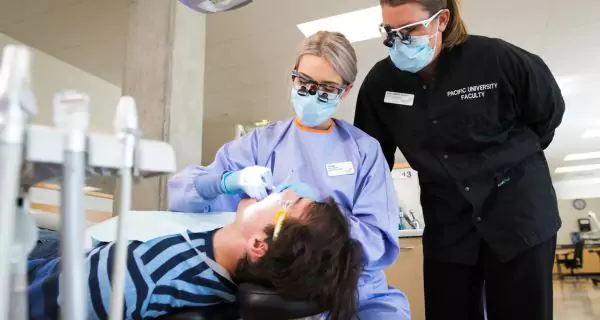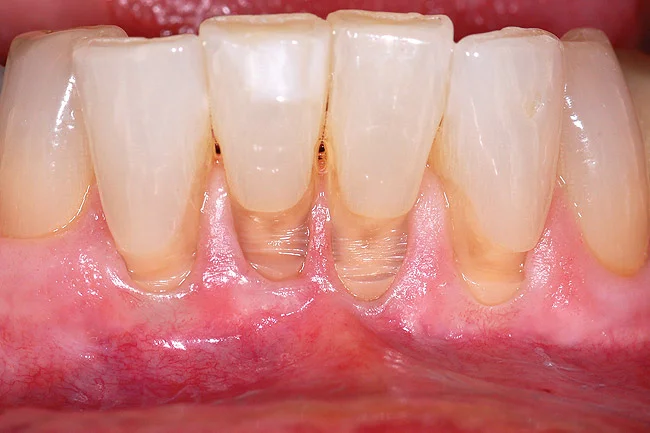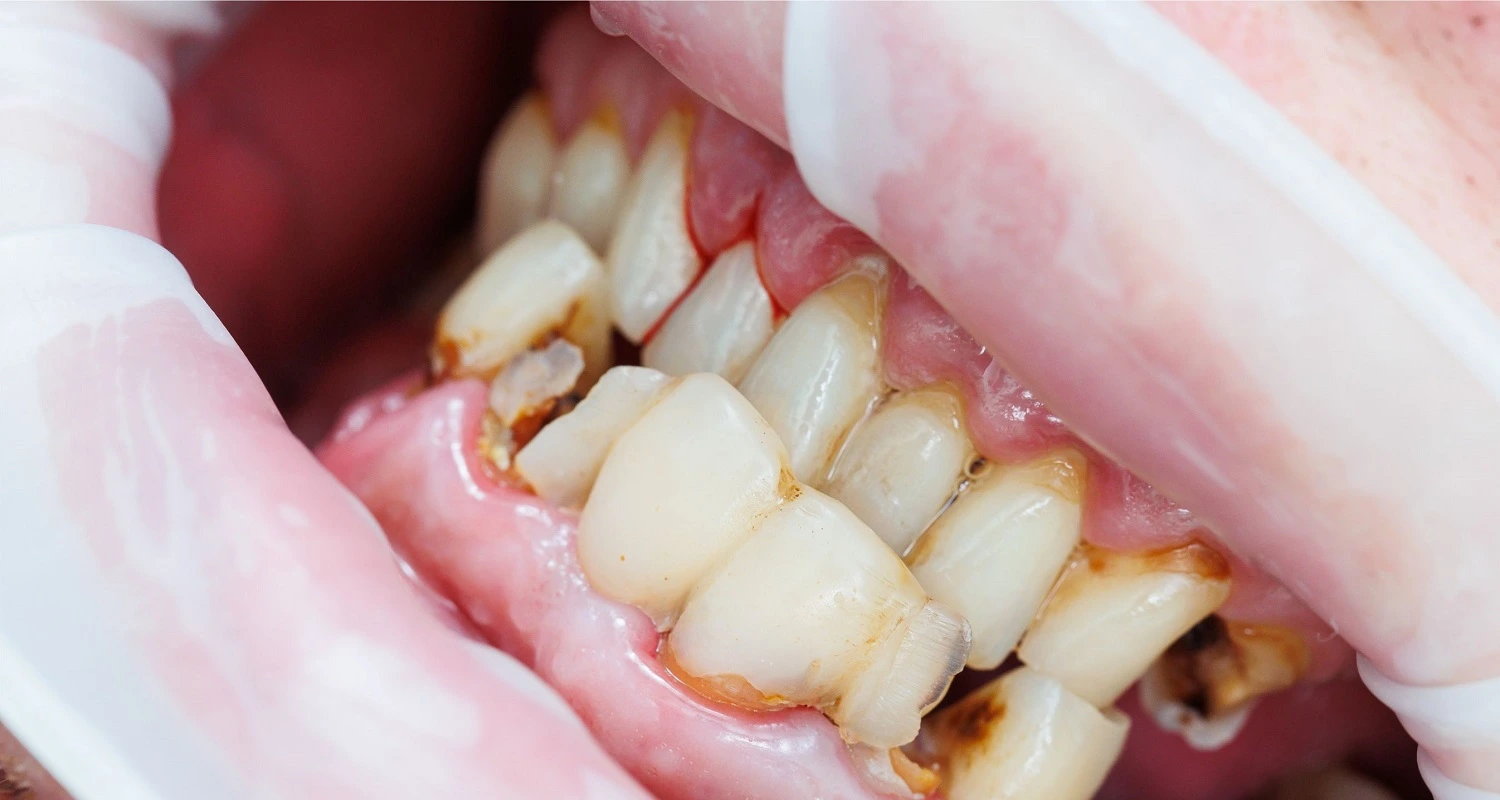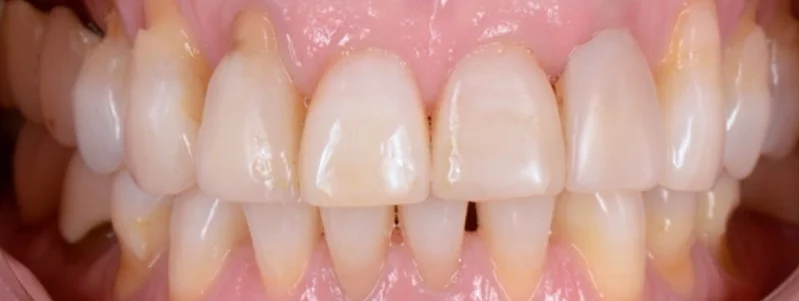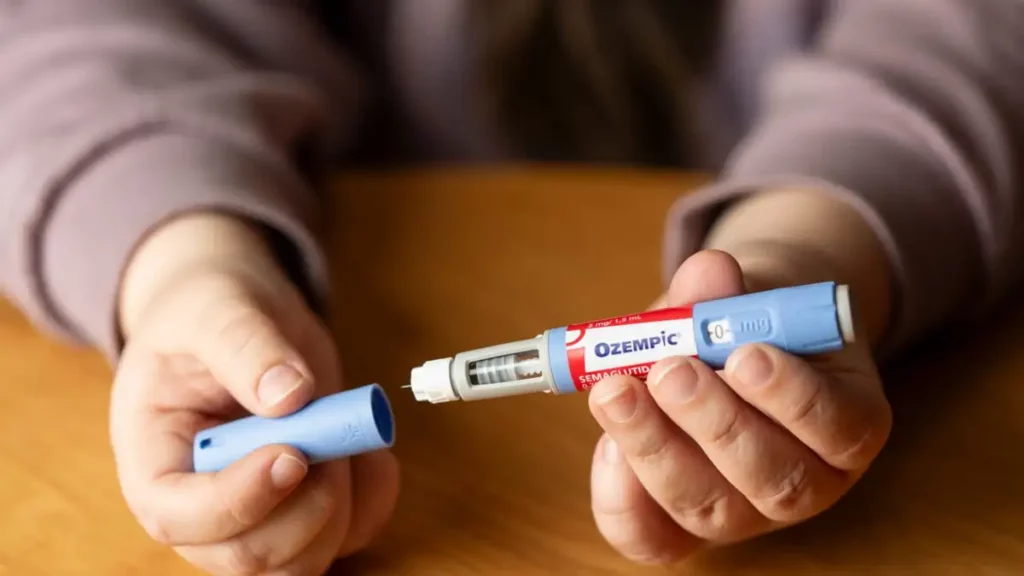Last Updated on: 19th September 2025, 12:51 pm
Multiple lesions affect the teeth that are not necessarily cavities; among the most common is dental wear, better known as Non-Carious cervical lesions. They are progressive and slowly damage the tooth. What signs and symptoms do these lesions present and what causes them? We will now expand on the topic.
What are Non-carious Cervical Lesions?
These lesions are defined as wear or loss of the hard dental tissue known as enamel and dentin. This is the outermost layer of the tooth that serves to protect the nerve.
They are called cervical lesions because of the area where they are observed. They usually occur in the front part of the teeth, near the gums.
This is the location of the Amélica cement joint, which is the division between the visible part of the tooth called a crown, and the root inside the gums. At this point, the enamel is thinner and more sensitive to temperature changes and touch.
The symptoms are very similar to those of dental caries; You may experience increased sensitivity of the teeth during brushing and when eating hot or cold food and drinks. These signs are among the main reasons people visit the dentist every year.
One of the treatments for non-carious cervical lesions is dental bonding. It can improve the appearance of the tooth, reduce sensitivity, and protect the exposed tooth structure from further damage. However, it’s essential to maintain good oral hygiene practices and avoid habits that contribute to the development of such lesions to prevent future issues.
According to the cause of the lesion’s appearance, non-carious cervical lesions it may be categorized as abfraction, abrasion, erosion, and attrition.
1. Abfraction
Abfraction is a loss of tooth structure of variable size, observed as a deep, wedge-shaped cavity, with defined edges, near or at the level of the gum. It can occur in one or several teeth at the same time.
What causes it?
Bruxism
the clenching and grinding of the teeth, which occurs unconsciously, especially at night.
Dental malocclusion
During chewing, the upper and lower teeth must adjust in a specific way so that the chewing force is distributed evenly. When this does not happen, anomalies appear in the bite; teeth do not protect each other but cause damage, engendering this type of injury.
2. Abrasion
Abrasion refers to the loss of dental structure due to a mechanical cause. It is observed as lines or ridges on the tooth, but as it progresses, these lines change color to yellow-brown. In more severe cases, it can affect the gums, causing them to retract such that part of the root of the tooth is uncovered.
What causes it?
Improper brushing of the teeth
Many people think that using a hard-bristled toothbrush and exerting a lot of force when cleaning the teeth is ideal, but in fact, that is a poor brushing technique.
Constant use of dental picks
Toothpicks are very thick; When used to clean between the teeth, they do not reach the most difficult-to-reach areas and additionally move the gums back, causing them to recede and form dental abrasion.
This type of injury can be avoided by applying an adequate oral hygiene technique, effectively using the toothbrush, toothpaste, dental floss, and mouthwash -all the necessary for healthy teeth and mouth.
3. Erosion
Erosion is evident damage to the dental structure. It is caused by chemical agents, specifically acids of external or internal origin. In addition to sensitivity, it may present small grooves at the level of the tooth, and the color changes to a yellowish tone. If you would like to explore the article related to signs and symptoms of enamel erosion, please feel free to check it out.
What causes it?
The cause depends upon the origin of the acids that affect the teeth. Therefore it is categorized as follows:
Intrinsic erosion
It occurs when the causes are acids from the human body itself, for example, gastric acids that are very common in people with stomach diseases.
Extrinsic erosion
This occurs due to the high consumption of foods rich in acids or sweets, intake of medications, alcohol, and constant vomiting, among others.
You should try to maintain a diet as balanced as possible to avoid damaging erosion as much as possible.
4. Attrition
Unlike previous injuries, attrition is wear at the level of the incisal or occlusal edges of the teeth, that is, the area where the lower teeth contact the upper ones.
When this condition occurs, depending upon the level of severity, small fracture lines can be observed on the edge of the teeth, a change in color to a yellowish tone, or the front teeth become shorter while the back teeth are smooth.
What causes it?
Physiological attrition
This type of wear occurs progressively as a result of age and the use of teeth over time. Normally does not present any discomfort.
Pathological attrition
Occurs with a habit such as bruxism or with dental malocclusions. It is commonly accompanied by abfractal lesions in the cervical area of the teeth.
Although initially none of these lesions is carious since there is loss of enamel and the presence of cavities on the dental surface, in addition to the sensitivity and discomfort it may present, bacterial plaque can lodge there and easily develop caries.
A person observes changes in the external surface of the tooth, and increased sensitivity to thermal stimuli or touch, it is imperative to consult a dentist as soon as possible, so they can be diagnosed and treated in time. It will avoid complications in the future.
The treatment of these injuries depends directly upon the type of injury, the origin, and the medical and dental history of each patient.
Frequently Asked Questions
What are non-carious cervical lesions, morphology, and progression?
Non-carious cervical lesions (NCCLs) involve the wear or loss of enamel and dentin in the cervical area of the teeth, near the gums, showing increased sensitivity to temperature changes. They progress slowly and can result from abfraction, abrasion, erosion, or attrition.
Causes of non-carious cervical lesions
The causes of NCCLs vary by type: abfraction is often due to bruxism and dental malocclusion; abrasion from improper brushing and dental picks; erosion from intrinsic body acids like gastric acids or extrinsic acids from diet; and attrition from physiological wear or pathological conditions such as bruxism.
How to prevent NCCLs?
Prevention of NCCLs includes using a soft-bristled toothbrush and gentle brushing, avoiding acidic foods and beverages, and managing bruxism or malocclusion with professional dental care.
Restorative options for non-carious cervical lesions
Restorative treatments depend on the lesion’s severity and may include resin composite fillings, glass ionomer cements, or dental crowns to protect and restore the tooth structure.
Factors associated with non-carious cervical lesions
Factors leading to NCCLs include mechanical forces like bruxism, chemical exposure to dietary or gastric acids, and physiological or pathological wear from aging or dental malocclusion.
It’s important to seek prompt dental consultation if you notice tooth surface changes or increased sensitivity to prevent further complications.
Share:
References
1. Alfred D. Wyatt Jr., DMD. Tooth Enamel Erosion and Restoration. WebMD. Reviewed: June 07, 2020 (Consulted January 11, 2023). Available in: https://www.webmd.com/oral-health/guide/tooth-enamel-erosion-restoration
2. Goodacre, CJ, Eugene Roberts, W, Munoz, CA. Noncarious cervical lesions: Morphology and progression, prevalence, etiology, pathophysiology, and clinical guidelines for restoration. J Prosthodont. 2022; 1– 18. Available in: https://onlinelibrary.wiley.com/doi/10.1111/jopr.13585
3. Healthline. Abfraction: Symptoms, Causes, and How to Treat. Reviewed: May 31, 2019 (Consulted January 12, 2023). Available in: https://www.healthline.com/health/abfraction
4. Ravi, Rama & Alla, Rama Krishna & Mohammed, Shammas & venkat ramesh, Santosh. (2013). Non-carious lesions due to tooth surface loss: A Review. Dental Era – A Journal of Dentistry. 3. 35 – 40. Available in: https://www.researchgate.net/publication/259018999_Non-carious_lesions_due_to_tooth_surface_loss_A_Review
5. Shellis, R. P., & Addy, M. (2014). The interactions between attrition, abrasion, and erosion in tooth wear. Monographs in oral science, 25, 32–45.
-
Nayibe Cubillos M. [Author]
Pharmaceutical Chemestry |Pharmaceutical Process Management | Pharmaceutical Care | Pharmaceutical Services Audit | Pharmaceutical Services Process Consulting | Content Project Manager | SEO Knowledge | Content Writer | Leadership | Scrum Master
View all posts
A healthcare writer with a solid background in pharmaceutical chemistry and a thorough understanding of Colombian regulatory processes and comprehensive sector management, she has significant experience coordinating and leading multidisciplina...

